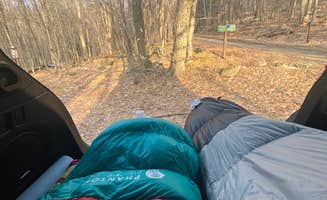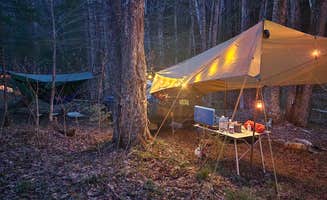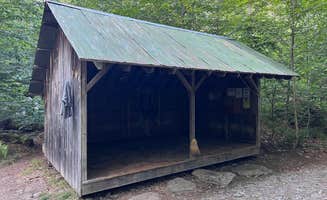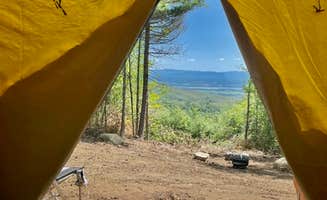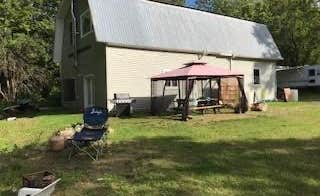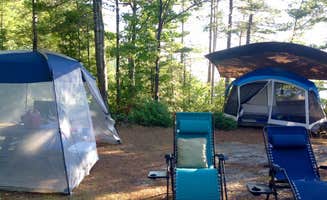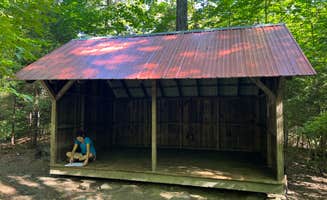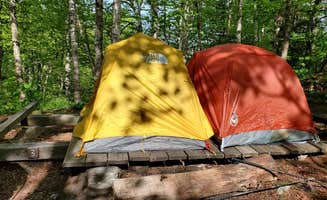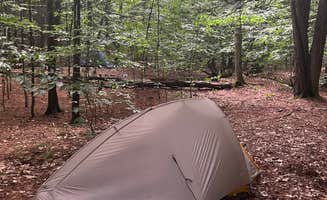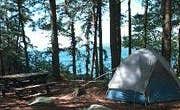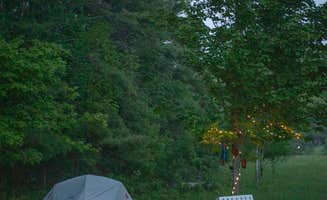Green Mountain National Forest offers several dispersed camping options near Goshen, Vermont, with sites located between 1,500-2,500 feet elevation. Most tent campsites near Goshen, Vermont require high-clearance vehicles during spring thaw, with muddy conditions common through May. Primitive camping spots along forest roads typically require campers to position at least 200 feet from water sources and 100 feet from trails.
What to do
Swimming options: Several dispersed camping areas feature swimming holes. At Patterson Brookside camp on West Hill Road, campers enjoy direct river access. "The dirt road along the river is an easy drive, though it is single lane in a few locations," notes reviewer Miccal M. Look for natural pools where the current slows.
Winter snowshoeing: For winter adventurers, Michigan Brook Road provides access to backcountry skiing and snowshoeing trails. "If you would like to continue down the service road during winter months I would highly recommend snowshoes or a snowmobile," warns Keegz M. at Michigan Brook Road Camping. Winter visitors should check for road closures beforehand.
Hiking connections: Stony Brook offers tent platforms with access to the Appalachian Trail. According to Justin P., "This stop stood out because of a brand new privvy, large tenting areas, and a swimming hole and consistent water just a bit further down the trail." Bear boxes at this location protect food from wildlife.
What campers like
Riverside sites: Tent campers value spots along waterways. At Green Mountain National Forest FR25, Sigrid O. reports, "Gorgeous stream/river...love the river sounds." Sites along water provide natural white noise and cooling during summer months.
Privacy levels: Some areas offer more seclusion than others. At Michigan Brook, TRUCKER C. notes, "There's 3 camping spots. 1 before the bridge and 2 after the bridge! The one before the bridge that's right next to the river is the best one!!" Campers seeking more privacy should arrive mid-week.
Quick weekend access: Many sites serve as convenient basecamps for exploring nearby attractions. Maggie F. found Michigan Brook useful as "accessibility to Killington, VT and it was of course free!" Most dispersed sites are within 30-45 minutes of regional hiking trails, mountain biking networks, and small towns with supplies.
What you should know
Site availability challenges: Popular free sites fill quickly on weekends. Helen P. visited Route 100 Dispersed Camping and found, "All the sites were full when I visited (6 to 8 sites approximately)." Arriving Thursday or Friday morning increases chances of securing a spot during peak season.
Road conditions: Many access roads deteriorate during wet periods. Thomas and James S. warn about Michigan Brook Road: "Road goes in pretty far. Some parts are muddy and very rough. Higher clearance would be advised!!!" Forest roads typically remain unplowed from November through April.
Facility limitations: No services means true self-sufficiency. At Patterson Brookside camp, Miccal M. cautions, "There is no electricity, no cell coverage, not outhouses in this area. Be prepared to pack out everything you bring in." Campers should bring water filtration systems or carry all needed water.
Tips for camping with families
Safety considerations: Sites near water require extra vigilance with children. The Michigan Brook area has multiple river-adjacent spots but requires preparation. Marcus notes Michigan Brook has "Nice little spots to hangout all day. Lots to see, and explore," but parents should establish clear boundaries near water.
Emergency planning: Lack of cell service means having contingency plans. At Last light on Michigan Brook, there's no reception. Keegz M. advises, "If you walk to the end of upper Michigan Brook road you will have cell phone service and a gas station along with a United States Post Office as well as a general store."
Weather readiness: Mountain weather changes rapidly. Melissa M. found FR25 "Beautiful sites on the River but with the wet summer, we just couldn't dry out." Pack extra tarps, rain gear, and dry clothes, especially during spring and fall when temperature swings of 30°F within 24 hours aren't uncommon.
Tips from RVers
Size limitations: Small trailers and camper vans work best at these sites. TRUCKER C. confirms Michigan Brook is accessible by car: "Drive in about a mile after the parking lot!! Can use car to get in!" Most forest roads have limited turnaround space, making sites unsuitable for trailers over 20 feet.
Security concerns: Unattended campsites may be vulnerable. Melissa M. warns about FR25, "Make sure to lock you valuables. Our Jackery, Solar panels & toilet were stolen." Consider bringing valuable gear with you when leaving camp for extended periods.
Leveling challenges: Natural terrain requires preparation. At Bingo, Rose notes "Couple of spots along the forest access road," but doesn't mention designated parking pads. Bring leveling blocks and scout sites before committing, as many have uneven surfaces requiring adjustment for comfortable sleeping.


